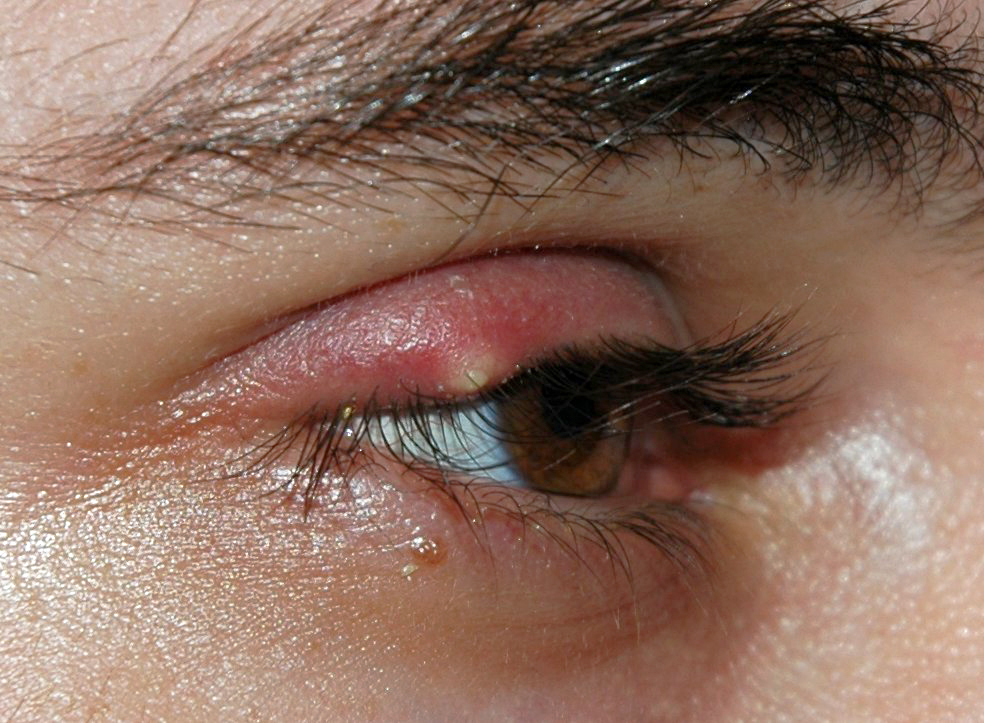Playlist
Show Playlist
Hide Playlist
Hordeolum (Stye) – Diseases of the Eyelids
-
Slides External Eye Diseases Diseases of the eyelids.pdf
-
Reference List Pathology.pdf
-
Download Lecture Overview
00:01 Let's talk about hordeolum or stye. 00:04 Most people know what styes are. 00:06 These are painful, typically little punctate areas of basically pus. 00:12 These are associated with eyelid hair follicles. 00:16 Okay, so it can be localized at the margin of the eye because that's where the hair follicles are. 00:22 And you can see it both in the diagram on the right, but also on that poor person on the left. 00:29 It is infection, typically, infection involving the eyelash follicle or the eyelid glands. 00:35 And these are those glands of Zeiss and Moll, whoever named those. 00:39 And they are basically sebaceous glands, modified sweat glands that are keeping the eyelashes supple. 00:45 That's what the glands of Zeiss and Moll do. 00:48 But they can become blocked. 00:49 They can become infected, and when they do, you get a stye. 00:53 OK, so this is just showing you on the left-hand side a typical pustule associated with a hair follicle. 01:01 So wherever there are hair follicles, there are going to be sebaceous glands. 01:04 It's kind of everywhere on your body and you can have a pimple anywhere on your body associated with similar sebaceous glands someplace else. 01:13 When it happens on the eyelid, we just give it the special name of hordeolum or stye. 01:16 So it's basically a pimple at the lash line. 01:21 Okay, and you're getting the pus that's there along the hair shaft. 01:26 So etiology, it's much more common in children and young adults, probably has to do a little bit with eye hygiene associated with rubbing the eyes. 01:36 So if you have your finger and it's not particularly clean with a little bit of Staph aureus on it and you rub it and you can get it into those little glands lining the hair shafts, they can then take over. 01:50 Can happen if there's chronic inflammation there or in settings like diabetes, which is going to impact the immune response. 01:57 So blepharitis, kind of otherwise inflammation of the eyelids can lead to this. 02:04 And it's going to be mainly a Staphylococcus aureus. 02:07 So a normal commensal organism that lives on the skin and can cause just a world of discomfort. 02:15 So there are complications that happen as a result of styes. 02:18 And if you have an inflammation of the glands of Moll or Zeiss, that can clearly impact the ability to get the sebaceous secretions from the Meibomian glands out. 02:31 So you can have a secondary chalazion that happens as a result of that infection of the kind of the eyelash glands. 02:41 Okay, next one is going to be a trigger so be prepared. 02:44 This looks awful, but it's a complication of styes. 02:48 You can have infection now that spreads into the entire eyelid and even into the other structures of the eye so an orbital or a preseptal cellulitis. 02:59 This can actually be quite serious and you can even develop abscesses as a result of this. 03:07 So what do you do to treat a stye? So it's usually quite conservative. 03:12 We want to give warm compresses and good eyelid hygiene. 03:16 And again, the compresses will bring that pimple to a head and allow it to have the release of the infected material and then you can wash it away. 03:27 In severe cases, we may require antibiotics. 03:30 And if there's lots and lots of inflammation, we may actually give steroids to block some of that. 03:38 In some cases, it may be required that we actually do incision and drainage, that we have to do a surgical treatment to get rid of the infection if there's a really large abscess.
About the Lecture
The lecture Hordeolum (Stye) – Diseases of the Eyelids by Richard Mitchell, MD, PhD is from the course External Eye Diseases.
Included Quiz Questions
A hordeolum affects what part of the eyes?
- The margin of the eyelid
- Upper eyelid
- Medial canthus
- Lateral canthus
- Lacrimal caruncle
What does the gland of Zeiss secrete?
- Sebum
- Meibum
- Mucus
- Keratin
- Tears
What condition may predispose a patient to develop a hordeolum?
- Diabetes
- Tuberculosis
- Leprosy
- Hypertension
- Anemia
What are the potential complications of a hordeolum?
- Chalazion and eyelid abscess
- Chalazion and blepharitis
- Chalazion and conjunctivitis
- Chalazion and iritis
- Chalazion and stye
Customer reviews
5,0 of 5 stars
| 5 Stars |
|
5 |
| 4 Stars |
|
0 |
| 3 Stars |
|
0 |
| 2 Stars |
|
0 |
| 1 Star |
|
0 |




